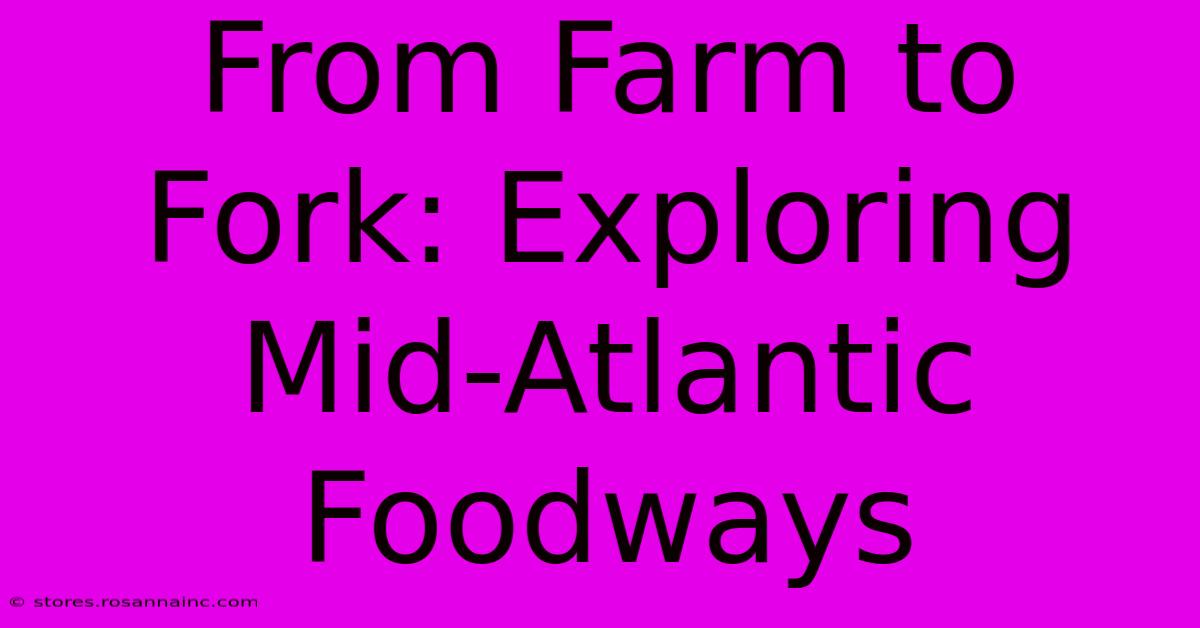From Farm To Fork: Exploring Mid-Atlantic Foodways

Table of Contents
From Farm to Fork: Exploring Mid-Atlantic Foodways
The Mid-Atlantic region, a culinary tapestry woven from diverse histories and geographies, boasts a rich and evolving food culture. From the Chesapeake Bay's bounty to the Appalachian foothills' hearty fare, understanding its "foodways"—the cultural, social, and economic practices surrounding food—offers a fascinating glimpse into the region's identity. This exploration delves into the journey of food, from farm to fork, highlighting the unique characteristics of Mid-Atlantic cuisine.
A Diverse Agricultural Landscape: The Foundation of Mid-Atlantic Foodways
The Mid-Atlantic's agricultural landscape is as diverse as its population. The fertile soils and varied climates support a wide range of agricultural products, forming the bedrock of its culinary traditions.
Key Agricultural Products:
-
Chesapeake Bay Seafood: Oysters, crabs, and rockfish are iconic staples, defining the region's coastal cuisine. Sustainable harvesting practices are crucial to maintaining these resources for future generations. The unique salinity and conditions of the Bay create a distinctive flavor profile in these seafood delicacies.
-
Fruits and Vegetables: Apples, peaches, and tomatoes thrive in the region's climate, contributing to vibrant farm-to-table initiatives and seasonal menus. Farmers markets overflow with locally grown produce, showcasing the region's agricultural prowess.
-
Livestock: From pasture-raised poultry to heritage breed pigs, livestock farming plays a significant role. Many farms prioritize humane and sustainable practices, reflecting a growing consumer demand for ethically sourced meat.
-
Grains: Wheat, corn, and barley are cultivated extensively, forming the basis for various baked goods and distilled spirits, integral parts of Mid-Atlantic food culture.
From Farm to Table: Connecting Consumers with Producers
The movement towards farm-to-table dining is gaining significant momentum in the Mid-Atlantic. This initiative fosters direct connections between consumers and producers, supporting local economies and ensuring food quality.
Supporting Local Farms:
-
Farmers Markets: These bustling markets offer a direct line to fresh, seasonal produce and other agricultural products. They provide a vital platform for farmers to connect with consumers and build relationships within their communities.
-
Community Supported Agriculture (CSA) Programs: CSAs allow consumers to subscribe to a share of a farm's harvest, receiving regular deliveries of fresh produce throughout the growing season. This model strengthens the bond between consumers and their food sources.
-
Farm-to-Table Restaurants: Increasingly, restaurants are sourcing ingredients directly from local farms, highlighting seasonal menus and supporting sustainable agriculture. These establishments showcase the region's unique culinary identity.
Culinary Traditions and Regional Variations: A Taste of the Mid-Atlantic
The Mid-Atlantic's cuisine reflects its diverse population and agricultural bounty. Regional variations exist, showcasing distinct culinary identities.
Notable Dishes and Traditions:
-
Maryland Crab Cakes: A culinary icon, these cakes showcase the region's abundance of blue crabs. Authentic recipes emphasize the use of minimal filler, highlighting the delicate crab meat.
-
Pennsylvania Dutch Cuisine: This hearty fare, rooted in German heritage, features dishes like pot pie, scrapple, and shoofly pie, reflecting the region’s rich agricultural history.
-
Virginia Ham: Known for its distinctive smoky flavor, Virginia ham is a testament to the region's expertise in meat curing and preservation.
The Future of Mid-Atlantic Foodways: Sustainability and Innovation
The future of Mid-Atlantic foodways hinges on sustainable practices and innovation. Balancing agricultural production with environmental conservation is crucial for preserving the region's unique culinary heritage.
Challenges and Opportunities:
-
Climate Change: Adapting farming practices to mitigate the impacts of climate change is a critical concern. Sustainable agricultural methods can help ensure the region's food security.
-
Food Waste Reduction: Minimizing food waste throughout the supply chain is essential for both environmental sustainability and economic viability.
-
Supporting Small Farms: Policies and initiatives that support small-scale, sustainable farms are crucial for maintaining the region's agricultural diversity and its unique culinary traditions.
The Mid-Atlantic’s foodways represent a rich and vibrant tapestry of cultural heritage, agricultural innovation, and culinary creativity. By understanding and supporting this dynamic system—from farm to fork—we can ensure the continuation of this vital aspect of the region's identity for generations to come.

Thank you for visiting our website wich cover about From Farm To Fork: Exploring Mid-Atlantic Foodways. We hope the information provided has been useful to you. Feel free to contact us if you have any questions or need further assistance. See you next time and dont miss to bookmark.
Featured Posts
-
Three Bags Full Escape The Ordinary With A Sheep Detective
Feb 10, 2025
-
Beyond The Green Door Your Transformation Starts Here
Feb 10, 2025
-
New Resources For Managing Student Behavior
Feb 10, 2025
-
Love Island Australia S5 Your Ultimate Guide To Summer Romance
Feb 10, 2025
-
Raja Ampat Islands Cure Your Wanderlust In Paradise
Feb 10, 2025
